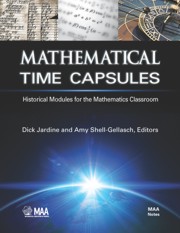Book contents
- Frontmatter
- Preface
- Contents
- 1 The Sources of Algebra
- 2 How to Measure the Earth
- 3 Numerical solution of equations
- 4 Completing the Square through the Millennia
- 5 Adapting the Medieval “Rule of Double False Position” to the Modern Classroom
- 6 Complex Numbers, Cubic Equations, and Sixteenth-Century Italy
- 7 Shearing with Euclid
- 8 The Mathematics of Measuring Time
- 9 Clear Sailing with Trigonometry
- 10 Copernican Trigonometry
- 11 Cusps: Horns and Beaks
- 12 The Latitude of Forms, Area, and Velocity
- 13 Descartes' Approach to Tangents
- 14 Integration à la Fermat
- 15 Sharing the Fun: Student Presentations
- 16 Digging up History on the Internet: Discovery Worksheets
- 17 Newton vs. Leibniz in One Hour!
- 18 Connections between Newton, Leibniz, and Calculus I
- 19 A Different Sort of Calculus Debate
- 20 A ‘Symbolic’ History of the Derivative
- 21 Leibniz's Calculus (Real Retro Calc.)
- 22 An “Impossible” Problem, Courtesy of Leonhard Euler
- 23 Multiple Representations of Functions in the History of Mathematics
- 24 The Unity of all Science: Karl Pearson, the Mean and the Standard Deviation
- 25 Finding the Greatest Common Divisor
- 26 Two-Way Numbers and an Alternate Technique for Multiplying Two Numbers
- 27 The Origins of Integrating Factors
- 28 Euler's Method in Euler's Words
- 29 Newton's Differential Equation ẏ/ẋ = 1 − 3x + y + xx + xy
- 30 Roots, Rocks, and Newton-Raphson Algorithms for Approximating √2 3000 Years Apart
- 31 Plimpton 322: The Pythagorean Theorem, More than a Thousand Years before Pythagoras
- 32 Thomas Harriot's Pythagorean Triples: Could He List Them All?
- 33 Amo, Amas, Amat! What's the sum of that?
- 34 The Harmonic Series: A Primer
- 35 Learning to Move with Dedekind
- About the Editors
29 - Newton's Differential Equation ẏ/ẋ = 1 − 3x + y + xx + xy
- Frontmatter
- Preface
- Contents
- 1 The Sources of Algebra
- 2 How to Measure the Earth
- 3 Numerical solution of equations
- 4 Completing the Square through the Millennia
- 5 Adapting the Medieval “Rule of Double False Position” to the Modern Classroom
- 6 Complex Numbers, Cubic Equations, and Sixteenth-Century Italy
- 7 Shearing with Euclid
- 8 The Mathematics of Measuring Time
- 9 Clear Sailing with Trigonometry
- 10 Copernican Trigonometry
- 11 Cusps: Horns and Beaks
- 12 The Latitude of Forms, Area, and Velocity
- 13 Descartes' Approach to Tangents
- 14 Integration à la Fermat
- 15 Sharing the Fun: Student Presentations
- 16 Digging up History on the Internet: Discovery Worksheets
- 17 Newton vs. Leibniz in One Hour!
- 18 Connections between Newton, Leibniz, and Calculus I
- 19 A Different Sort of Calculus Debate
- 20 A ‘Symbolic’ History of the Derivative
- 21 Leibniz's Calculus (Real Retro Calc.)
- 22 An “Impossible” Problem, Courtesy of Leonhard Euler
- 23 Multiple Representations of Functions in the History of Mathematics
- 24 The Unity of all Science: Karl Pearson, the Mean and the Standard Deviation
- 25 Finding the Greatest Common Divisor
- 26 Two-Way Numbers and an Alternate Technique for Multiplying Two Numbers
- 27 The Origins of Integrating Factors
- 28 Euler's Method in Euler's Words
- 29 Newton's Differential Equation ẏ/ẋ = 1 − 3x + y + xx + xy
- 30 Roots, Rocks, and Newton-Raphson Algorithms for Approximating √2 3000 Years Apart
- 31 Plimpton 322: The Pythagorean Theorem, More than a Thousand Years before Pythagoras
- 32 Thomas Harriot's Pythagorean Triples: Could He List Them All?
- 33 Amo, Amas, Amat! What's the sum of that?
- 34 The Harmonic Series: A Primer
- 35 Learning to Move with Dedekind
- About the Editors
Summary
“But this will appear plainer by an Example or two.”
— Newton (1671)After outlining his general method for finding solutions of differential equations.
Introduction
In this note we redress Newton's solution to his differential equation in the title above in a contemporary setting. We resurrect Newton's algorithmic series method for developing solutions of differential equations term-by-term. We provide computer simulations of his solution and suggest further explorations.
The only requisite mathematical apparatus herein is the knowledge of integration of polynomials. Therefore, this note can be used in a calculus course or a first course on differential equations. Indeed, the author used the content of this paper while covering the method of series solutions in an elementary course in differential equations. Additional specific examples studied by the luminaries in the early history of differential equations are available in [1]. This work was supported by the National Science Foundation's Course, Curriculum, and Laboratory Improvement Program under grant DUE-0230612
Newton's differential equation
Newton's book [6], ANALYSIS Per Quantitatum, SERIES, FLUXIONES, AC DIFFERENTIAS: cum Enumeratione Linearum TERTII ORDINIS consists of one dozen problems. The second problem
PROB. II An Equation is being proposed, including the Fluxions of Quantities, to find the Relations of those Quantities to one another
is devoted to a general method of finding the solution of an initial-value problem for a scalar ordinary differential equation in terms of series. The equation in the title of the present paper (see also Figure 29.1) is the first significant example in the section on PROB. II.
Newton thought of mathematical quantities as being generated by a continuous motion.
- Type
- Chapter
- Information
- Mathematical Time CapsulesHistorical Modules for the Mathematics Classroom, pp. 223 - 228Publisher: Mathematical Association of AmericaPrint publication year: 2011



